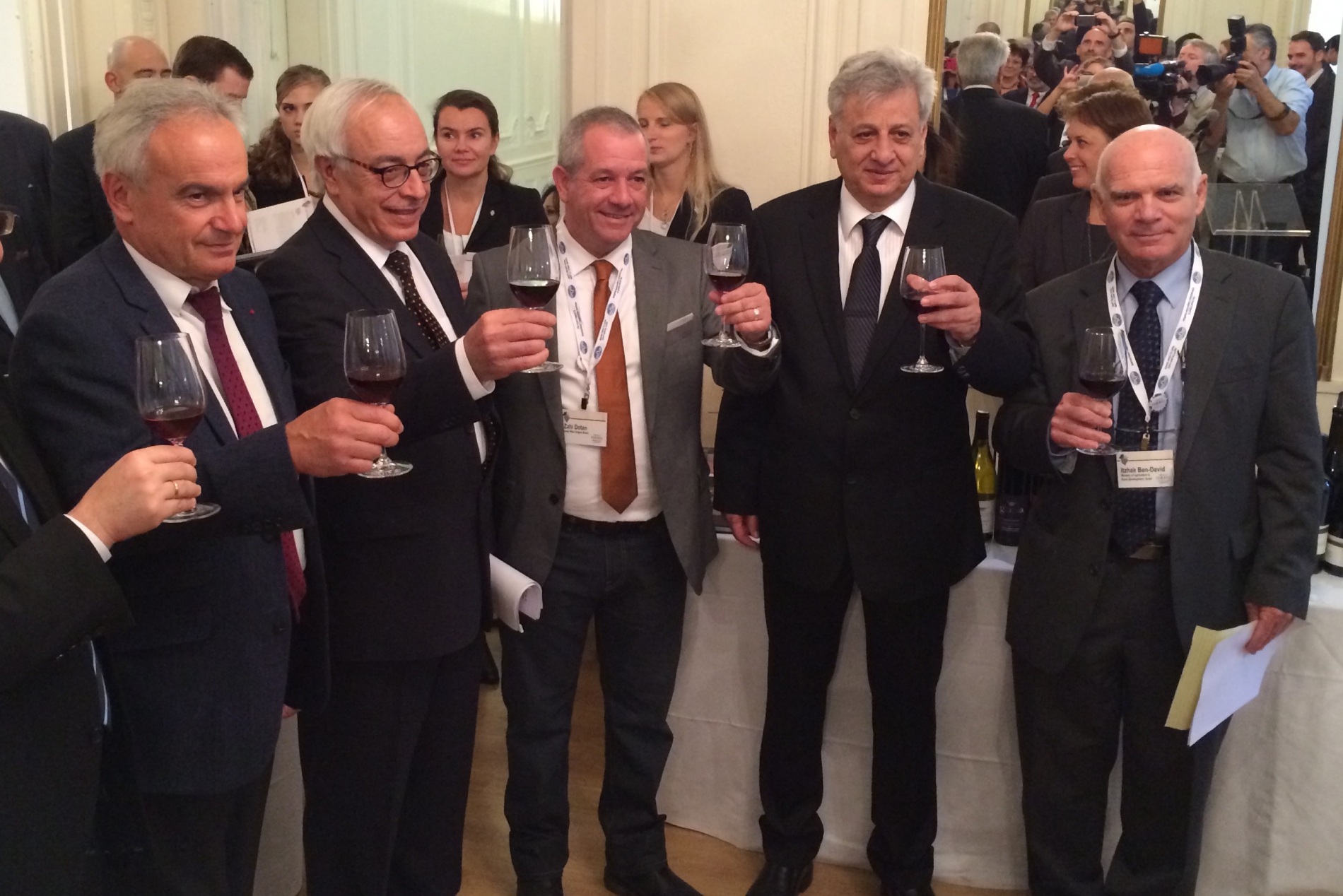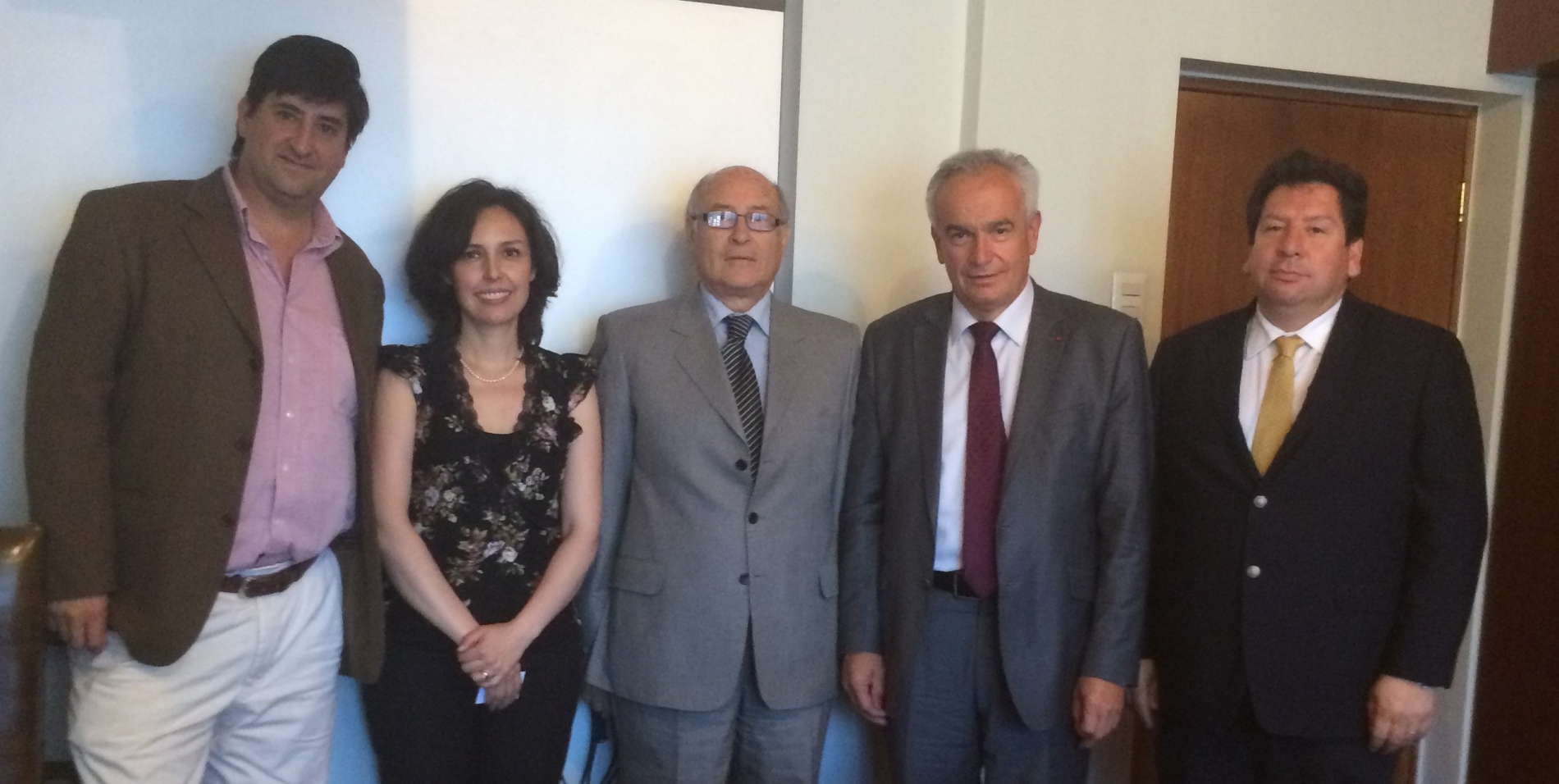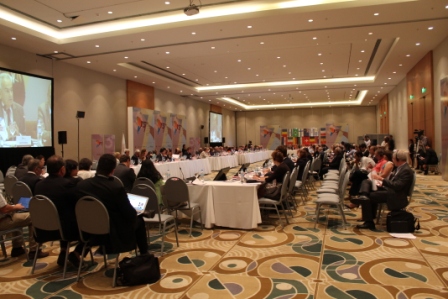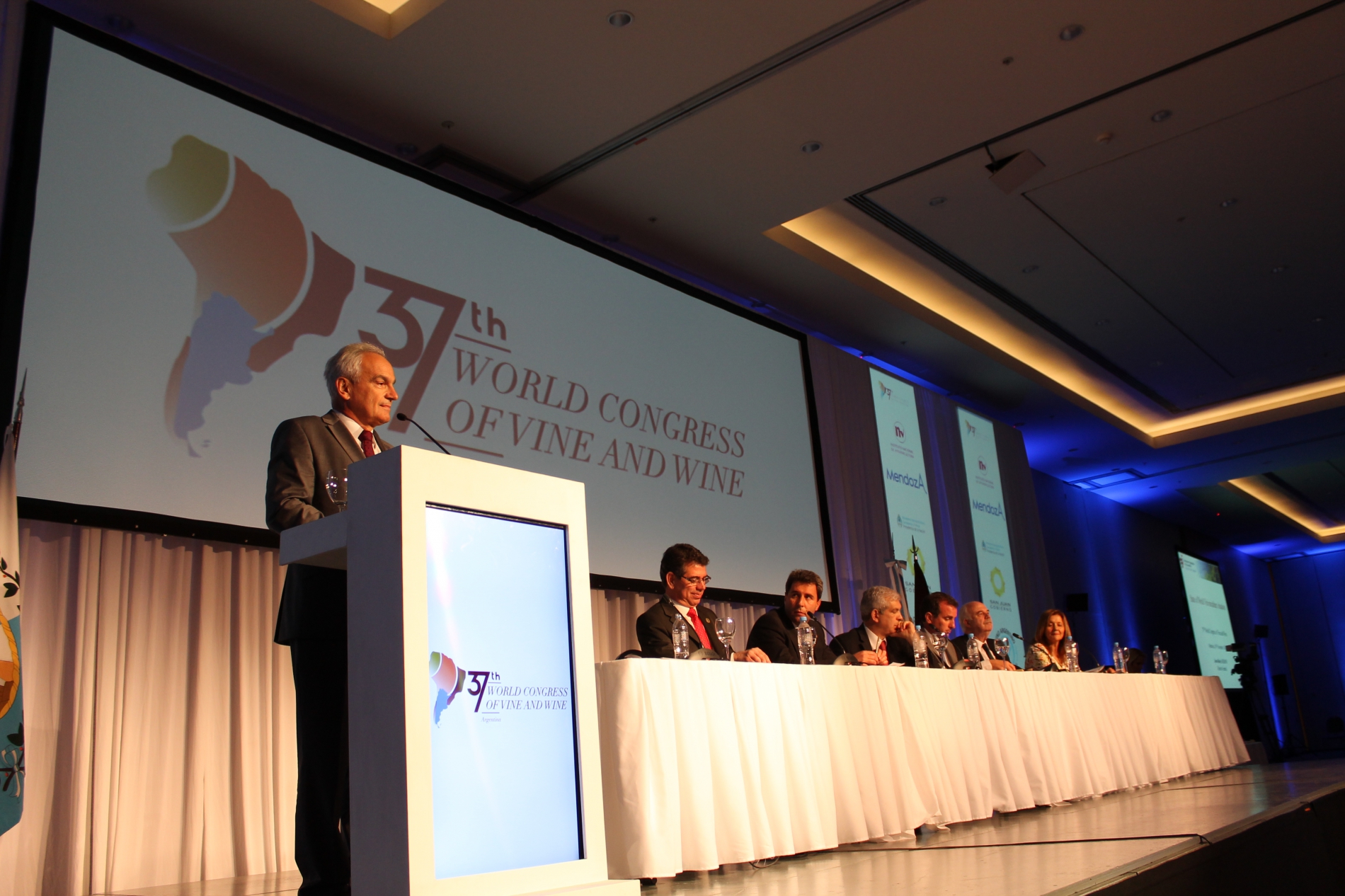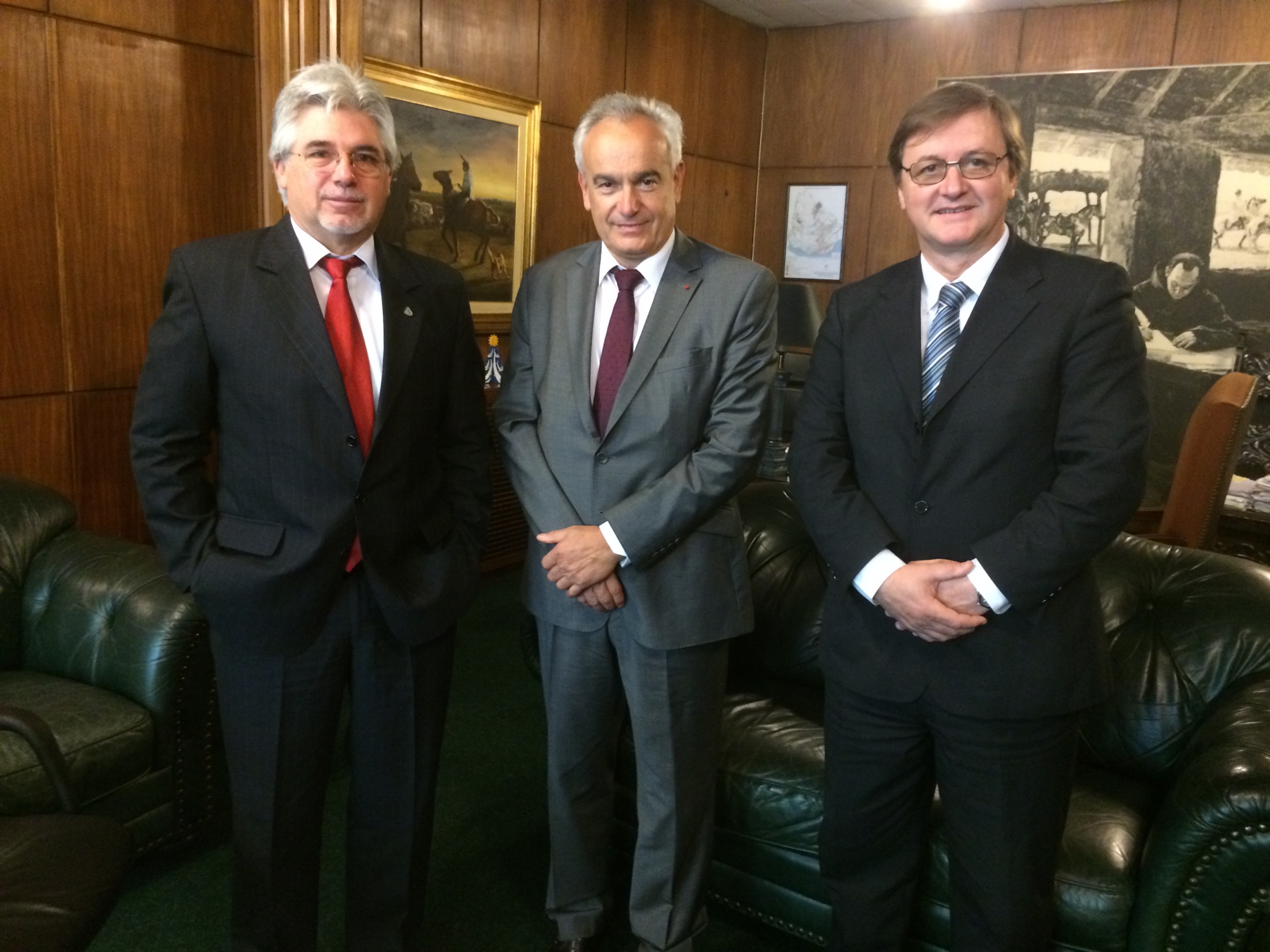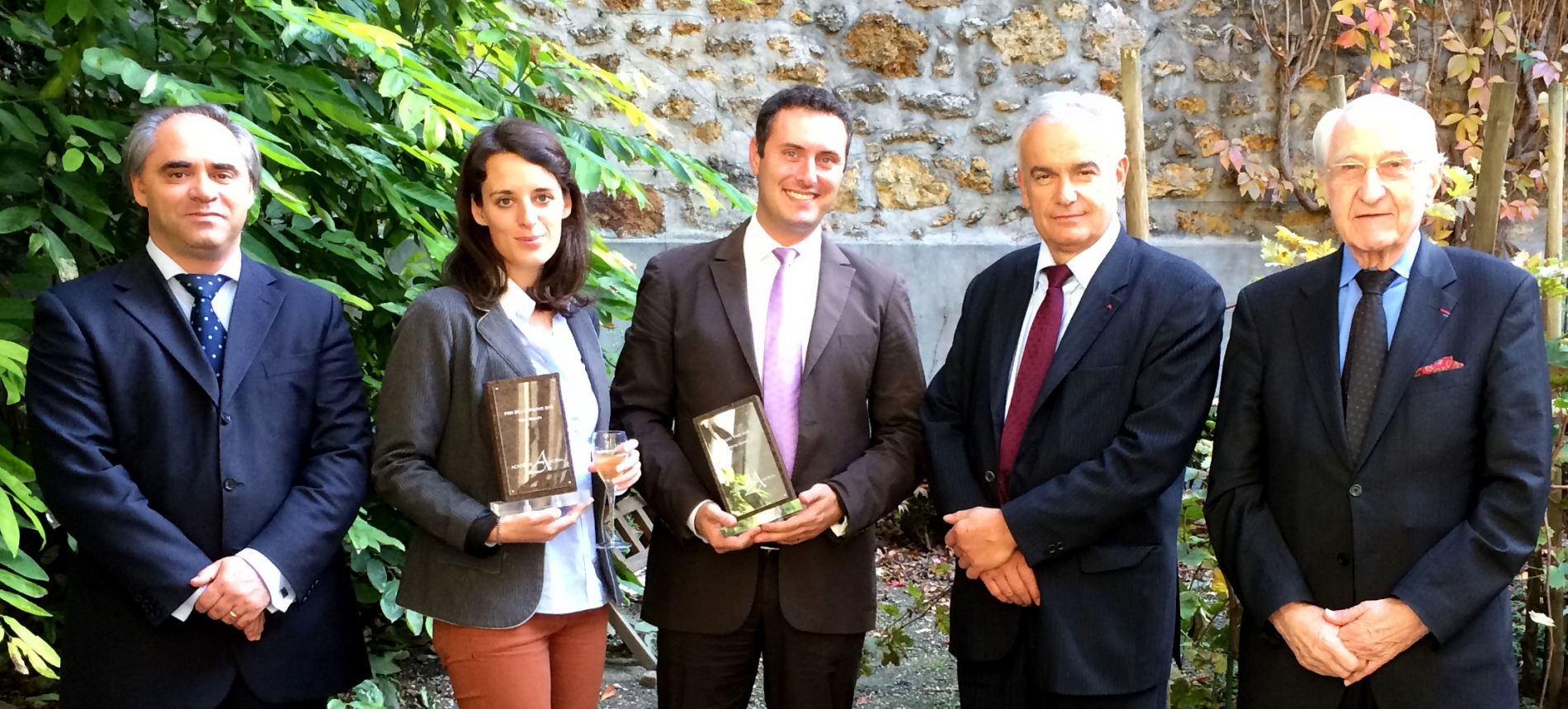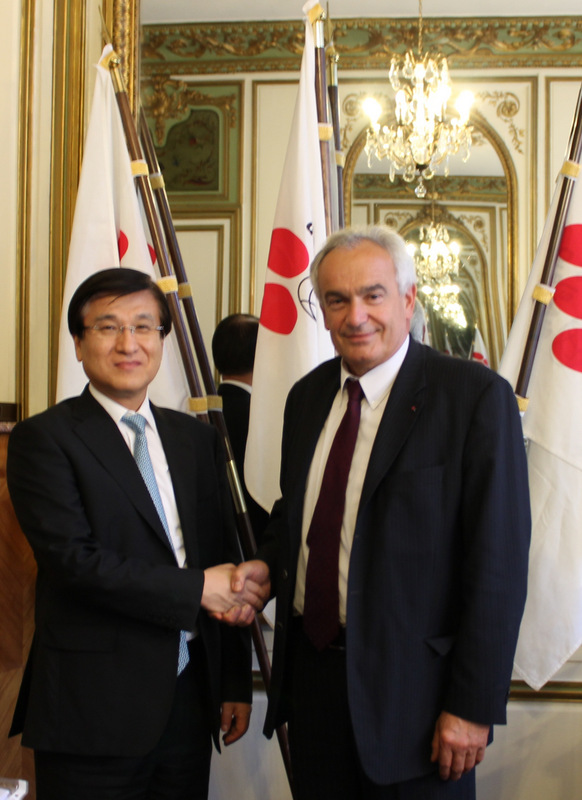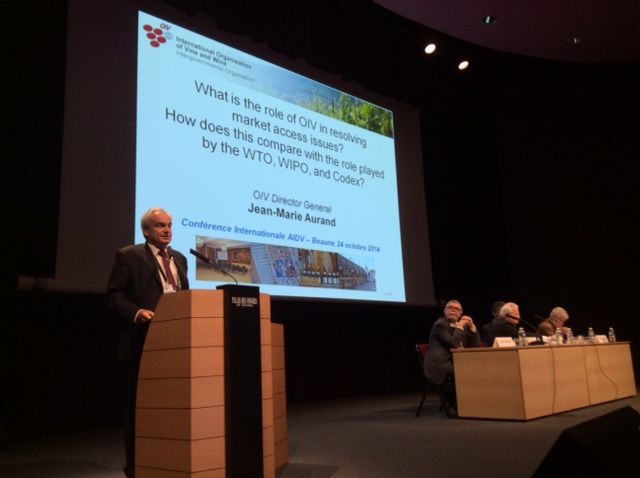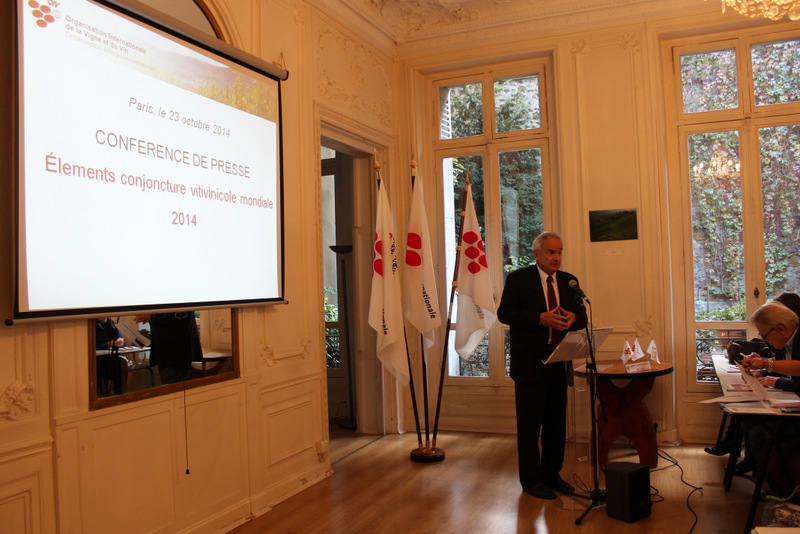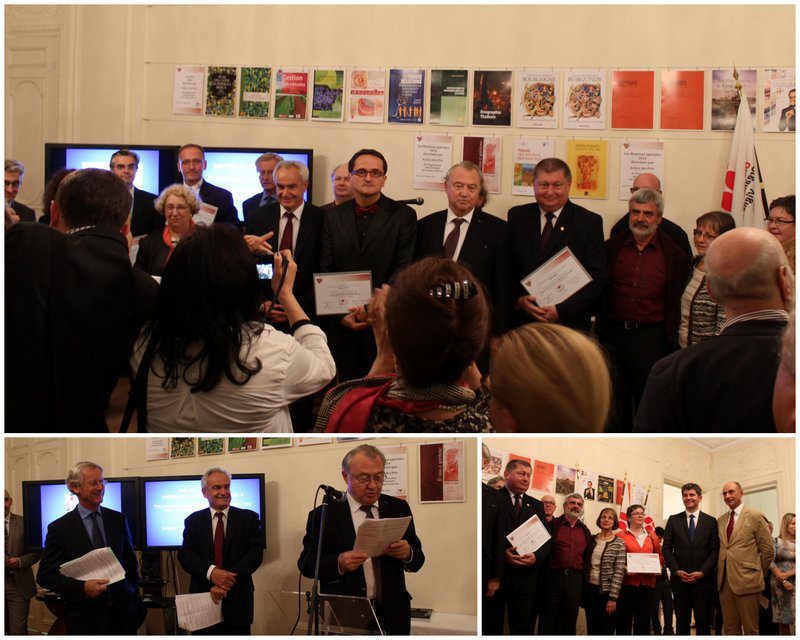24 Nov 2014
This presentation follows the OIV Director General's visit in September to present, to professionals in the sector, the technical and scientific activities of the OIV, as well as to strengthen cooperation of expertise. The Director General of the Israeli Ministry of Agriculture, Mr Ramy Cohen, was delighted that, for the second time at the OIV headquarters, Israeli viticulture had the opportunity to become better known as one of the components of Mediterranean wine culture. From left to right:Jean-Marie Aurand, OIV Director General - Yossi Gal, Israeli Ambassador in France - Zahi Dotan, Director General of the Israel Wine Grapes Board - Ramy Cohen, Director General, Ministry of Agriculture - Itzik Ben David, Deputy Director General for Foreign Trade, Ministry of Agriculture
19 Nov 2014
On this occasion, Jean-Marie Aurand met the National Director of the Agriculture and Livestock Department, Mr Angel Sartori, in the presence of the Head of the Sub-department of Vitiviniculture, Food Safety and Biotechnology, Ms Alejandra Aburto Prieto, the OIV delegate, Mr Joaquín Almarza Serrano, and the Head of the Department of Agriculture and Forestry Protection, Mr Rodrigo Astete Rocha.During this meeting, the National Director of the Agriculture and Livestock Department recalled that Chile had been a member of the OIV for more than 60 years. He also stressed the importance that his country, as a major player in the global market, attaches to the activities of the OIV and confirmed its full support of the Organisation.Jean-Marie Aurand expressed his desire for Chile to further strengthen its presence within the OIV by bringing together experts to participate in various work projects. While he was over there, several meetings were also organised with companies in the Chilean vitivinicultural sector, which resulted in a number of discussions about the world wine market, its developments and prospects.
17 Nov 2014
Decisions on Oenological PracticesSeveral resolutions relating to new oenological practices will be added to the International Code of Oenological Practices of the OIV, in particular:
- A new oenological practice on the treatment of wines using a membrane technique coupled with activated carbon to reduce excess 4-ethylphenol and 4-ethylguaiacol was accepted (Resolution OIV-OENO 504-2014). This physical treatment consists of using technologies combining nanofiltration and treatment with deodorising activated carbon, with the objective of reducing the content of 4-ethylphenol and 4-ethylguaiacol of microbial origin, which constitutes an organoleptic defect and masks the aromas of the wine.
- In addition, a Code of good vitivinicultural practices in order to avoid or limit contamination by Brettanomyces was adopted (Resolution OIV-OENO 462-2014). Among processes that deteriorate wine quality, the production of volatile phenols by Brettanomyces is widespread and increasingly problematic. The management of Brettanomyces is an important winemaking issue; Brettanomyces are reported to be involved in spoilage resulting in aromatic defects. This code determines the measures to be set up in vineyards and in wine cellars in order to contribute to reducing the risks linked to the presence of Brettanomyces.
- A monograph on PVI/PVP adsorbent copolymers. Various detailed specifications accompany this monograph, monomer limits in musts and wines in particular. This monograph thus supplements the oenological practice that permits the treatment of wines with this copolymer. (Resolution OIV-OENO 262-2014).
- A monograph on silver chloride (Resolution OIV-OENO 505-2014). This monograph relates to silver chloride used for adsorption by an inert support with a view to its use in wine. Silver chloride is used for the treatment of wines to remove fermentation- and storage-related abnormal odours (odours caused by reduction reactions, characterised by the presence of hydrogen sulphide and thiols).
- A method of determination of biogenic amines in wine by high-performance liquid chromatography with photodiode array detection (Resolution OIV-OENO 457-2014). The principle of this method is based on the coupling of a chromophore to the biogenic amines, which, by derivatisation, enables biogenic amines to be obtained that are visible by diode array detector.
- A method for the determination of lysozyme in wine using high-performance liquid chromatography (Resolution OIV-OENO 458-2014). This method describes the analytical procedure used to determine lysozyme in red and white wines. The determination can be carried out on the sample directly for white wines, but for red wines a dissociation of the enzyme from the polyphenolic macromolecules by means of sudden alkalinisation must be undertaken, using the principle of the amphoteric nature of the protein.
- A method for the determination of methanol in wine by gas chromatography (Resolution OIV-OENO 480-2014). This method, which replaces the existing method, is applicable to the quantification of methanol in wines for concentrations between 50 and 500 mg/L. Methanol is determined using gas chromatography coupled to detection using flame ionisation in the distillate, to which an internal standard is added.
- A modification to the method relating to the determination of the carbon isotope ratio 13C/12C of CO2 in sparkling wines: method using isotope ratio mass spectrometry (IRMS) was finally adopted (Resolution OIV-OENO 512-2014). The main changes concern, on the one hand, CO2 sampling procedures and, on the other hand, the addition of precision parameters defined as part of an inter-laboratory test.
10 Nov 2014
- 7519 mha is the worldwide area under vines in 2013
- Despite decrease in area under vine, the world production of grapes has been increasing (751 Mql) in 2013
- 271 Mhl is the first estimation for the wine produced in 2014
- Sparkling wine market has expanded in recent years: in 10 years production has increased by more than 40% and consumption by 30%.
07 Nov 2014
During a working meeting with the President of the National Institute of Vitiviniculture (INAVI), Mr José Lez Secchi, and members of the board, Mr Aurand gave a presentation on the situation of the vitivinicultural sector and its major developments on a global scale. This presentation was followed by a discussion regarding the position of Uruguayan viticulture within this context and the key issues it faces.The President of the INAVI confirmed that he wanted to further strengthen Uruguay's presence within the various working groups of the Organisation.During a meeting with the Minister for Agriculture, agricultural engineer Tabaré Aguerre, the Minister stressed the Government's desire to develop the vitivinicultural sector by promoting the production of quality wines and the image of the Tannat vine variety. The Minister also expressed the hope that Uruguay might host an OIV World Congress of Vine and Wine in the near future.Finally, Mr Aurand attended the presentation of awards to vitivinicultural companies who took part in "Catas solidarias", an approach based around solidarity with disadvantaged populations.
31 Oct 2014
One of the winners for the year 2014 was Mr Olivier Serra, whose history of law thesis on "Legislators and the vitivinicultural market under the French Third Republic" won him the Grand Prix. The Academy also gave a Prix d'initiative award to the Wine Mosaic organisation for their project, which protects and promotes little-known vine varieties. Mr Jean-Marie Aurand, Director General of the OIV, who was present at this ceremony, congratulated the award winners and highlighted the Amorim Academy's actions in favour of scientific research as well as the Academy's role as an observer of the OIV.
30 Oct 2014
Mr Aurand presented in detail the functions and activities of the OIV and the advantage for consumer countries, in particular, of being involved in the work and the scientific community of the Organisation. The Korean Ambassador highlighted the increase in wine consumption in his country, noting the growing share of Asian countries in global wine trade. The Director General of the OIV said that the contact he had made in Seoul with the ministries responsible for food and agriculture had led to a constructive dialogue and hoped that the Embassy could be an information relay to Korean Foreign Affairs in order to advance the idea of joining the OIV.
24 Oct 2014
More than 125 lawyers from 20 different countries participated in this meeting in Beaune, Burgundy on the topic of access to wine markets, along with speakers from intergovernmental organisations such as the WTO, the OIV or the EU, professional organisations, lawyers and specialist economists. http://www.aidv.org/2014frbeaune/index.htmlMr Aurand explained how the scientific and technical contribution of the OIV can facilitate the world wine trade, while recalling that its activities are carried out within the framework of other international agreements on intellectual property and trade.
23 Oct 2014
- France has once again become the biggest producer in the world (46.2 mhl), ahead of Italy, which saw a poor harvest (44.4 mhl)
- Spain has returned to an average level of production (37 mhl) after a record year in 2013
- Good level of production in the United States (22.5 mhl) for the 3rd consecutive year
- Significant decline in production in Chile (10 mhl) and in several Eastern European countries
- Record production on New Zealand (3.2 mhl) and high growth in Germany (9.7 mhl)
21 Oct 2014
H.E. Mr Lipka stressed the importance of this international recognition, which attracts a huge number of submissions every year from OIV Member Countries and non-Member Countries.This prestigious international award enables a readership seeking quality works to find bibliographic references for everything to do with knowledge and popularisation of the vine and wine sector, as well as to discover scientific works of a very high standard.The Director General of the OIV, Mr Jean-Marie Aurand, reminded those present that the 2014 award winners undoubtedly illustrate the OIV's decades-old vision of always being the world's reference organisation for vine and wine. These recognitions contribute to the promotion of the image of viticulture throughout the world, and its different dimensions: scientific and technical, economic, cultural, even historic.Finally, the President of the OIV Award Jury warmly congratulated the authors who won an award, as well as the publishers, for their cultural, technical or hedonistic contributions, each and every one of whose diverse approaches seeks to share a common passion for the vine and wine world.
